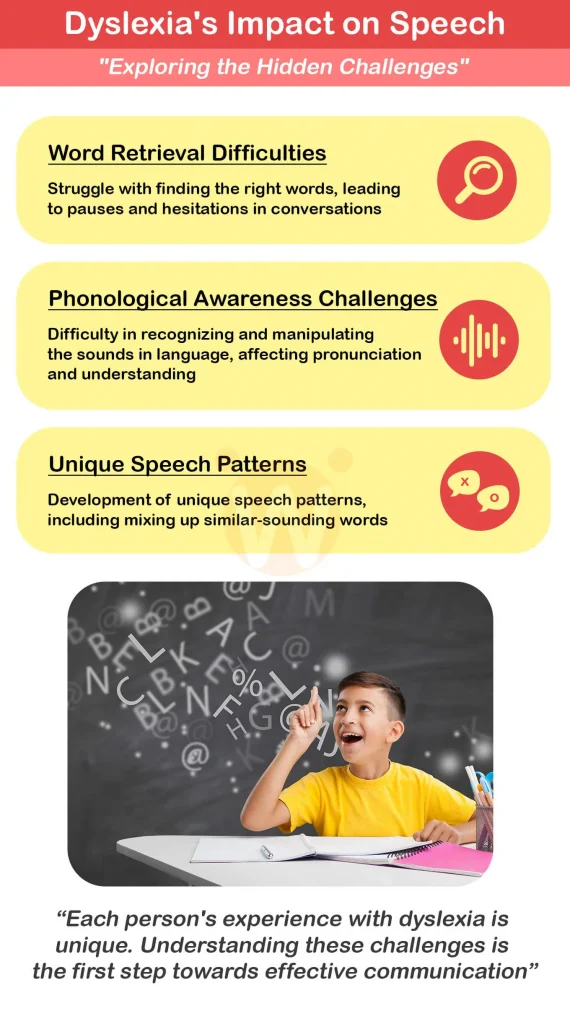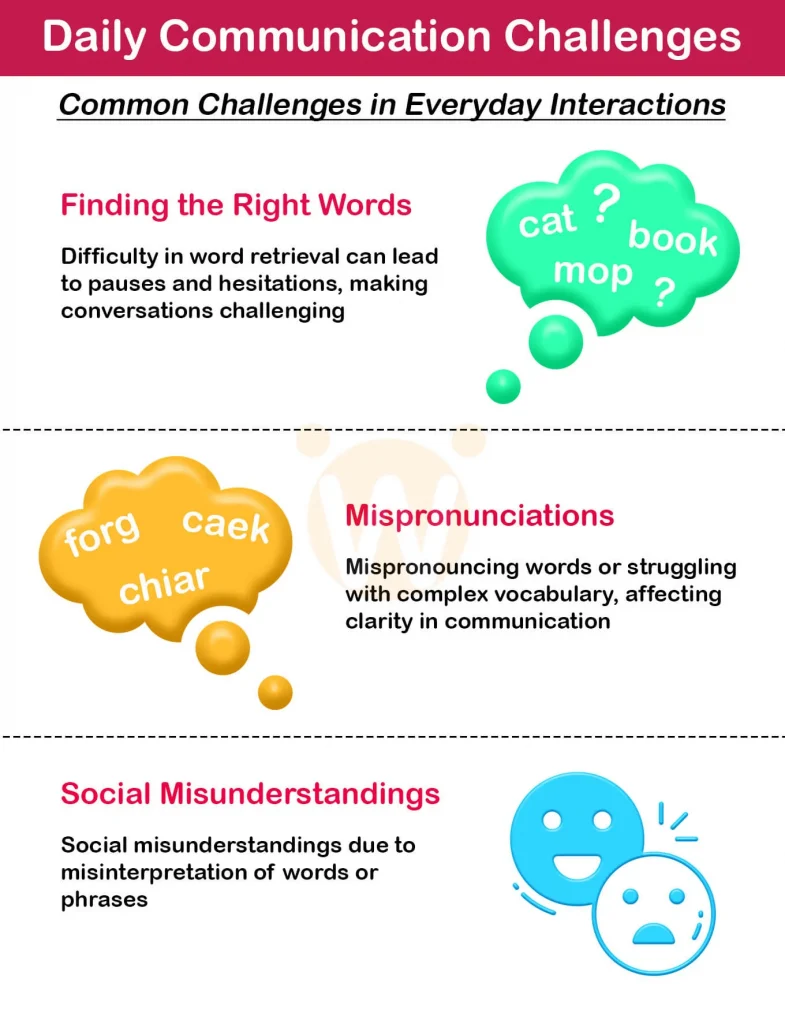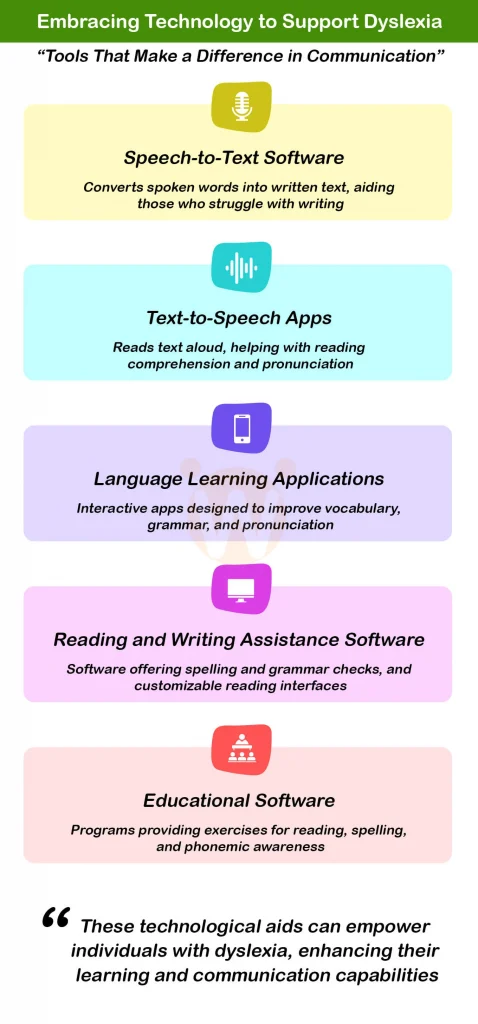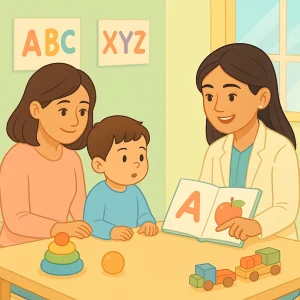Exploring the Impact of Dyslexia on Speech and Communication
By Rajini D
Last Updated: January 25, 2024
Dyslexia, a term we often hear, usually conjures images of jumbled letters and reading challenges. But did you know its impact extends far beyond the pages of a book? Today, let’s delve into a less discussed yet equally important aspect of dyslexia – its effect on speech and communication.
You might wonder, “How does a reading disorder influence the way we speak?” It’s a common question, and the answer is both fascinating and essential to understand. Dyslexia is not just about reading and writing difficulties; it also encompasses a range of speech and communication challenges. From finding the right words to expressing thoughts clearly, individuals with dyslexia navigate a complex world of linguistic hurdles every day.
Understanding Dyslexia
Definition and Overview
Dyslexia is more than just a buzzword in educational and psychological discussions; it’s a real, multifaceted learning disorder that affects millions worldwide. At its core, dyslexia is characterized by difficulties with accurate and/or fluent word recognition and poor spelling and decoding abilities. But what does this really mean?
Imagine trying to read a book, but the letters seem to dance and switch places, making it tough to make sense of the words. This is a daily reality for many with dyslexia. It’s not about intelligence – people with dyslexia are just as smart as anyone else – but their brains process written language differently. This often leads to challenges in reading, writing, and, as we’ll see, speech and communication.
Read more about on Overcoming Auditory Processing Disorder: Effective Strategies
Prevalence and Diagnosis
Dyslexia is surprisingly common, affecting between 5% and 10% of the population. But despite its prevalence, it often goes undiagnosed until later in life. This lack of early recognition can lead to years of frustration and confusion for those with dyslexia. That’s why early diagnosis is crucial. It opens the door to support and strategies that can make a world of difference in managing dyslexia’s challenges.
Dyslexia and Its Impact on Speech

Challenges in Word Retrieval
One of the less talked about but significant impacts of dyslexia is on speech, particularly in word retrieval. Ever had a word ‘on the tip of your tongue’? For those with dyslexia, this happens more frequently. They know what they want to say but struggle to find the right words. This can lead to pauses and hesitations in conversation, affecting both personal and professional interactions.
Phonological Awareness
A key player in dyslexia’s impact on speech is phonological awareness – the ability to recognize and manipulate the sounds in language. People with dyslexia often find it hard to break words down into their component sounds, making pronouncing new or complex words a challenge. This can lead to misunderstandings or reluctance to engage in conversations, especially in social or academic settings.
Learn more about early identification warning signs in child development.
Speech Patterns in Dyslexia
Dyslexia also brings unique speech patterns. Some might mix up sounds within words or use a similar-sounding word instead of the intended one. It’s not just a quirk; it’s a reflection of how their brain processes language. Recognizing these patterns is key to understanding and supporting individuals with dyslexia in their communication efforts.
Communication Barriers

Daily Communication Challenges
Dyslexia’s impact on communication is a daily reality for many, coloring their interactions in subtle yet significant ways. Imagine struggling to recall common words during a casual chat or misunderstanding spoken instructions due to difficulties in processing language sounds. These scenarios are common for individuals with dyslexia, turning routine conversations into a labyrinth of challenges.
In everyday settings, whether at work, in school, or during social gatherings, the hurdles of dyslexia can manifest in various ways. Mispronunciations, hesitations, and sometimes even avoiding speaking altogether are common coping strategies. It’s not just about the inability to find the right words; it’s about the hesitation and lack of confidence that comes with these experiences. These moments can lead to misunderstandings or the false perception of disinterest or lack of knowledge.
Find useful tips on handling communication difficulties in children.
Misconceptions and Social Impact
Misconceptions about dyslexia add another layer of complexity. There’s a widespread myth that dyslexia only affects reading and writing, but as we’ve seen, its impact on speech is profound. This misunderstanding can lead to underestimating the challenges faced by individuals with dyslexia, contributing to social stigmas.
These stigmas can have far-reaching effects. In school, children with dyslexia might be unfairly labeled as slow learners. In the workplace, adults may be overlooked for promotions due to their communication challenges. It’s essential to dispel these myths and understand dyslexia in its entirety to foster a more inclusive and supportive environment.
Strategies for Improvement and Coping Mechanisms
Enhancing Communication Skills
Improving communication for individuals with dyslexia isn’t just about overcoming challenges; it’s about harnessing their unique potential. Here are some practical tips and strategies:
- Practice Makes Perfect: Regular reading and speaking practice can significantly enhance language skills. Encourage reading aloud and engaging in conversations about diverse topics.
- Visual Aids: Utilize visual aids like charts and diagrams to reinforce understanding and aid memory.
- Break it Down: Learning to break words into smaller sounds (phonemes) can improve pronunciation and understanding.
- Slow and Steady: There’s no need to rush. Taking time to form thoughts and speak can reduce the pressure and improve clarity.
- Positive Reinforcement: Celebrate small victories. Positive reinforcement can boost confidence and motivation.
Read more on learning techniques for students.
Role of Support Systems
The journey with dyslexia is not a solitary one. Support from family, educators, and professionals is crucial:
- Family Support: A supportive home environment where individuals feel safe to express themselves without fear of judgment is invaluable.
- Educational Assistance: Teachers and educators can employ specialized teaching methods tailored to the needs of dyslexic students.
- Professional Guidance: Experts like those at Wellness Hub can provide tailored strategies and therapies to enhance communication skills and overall well-being.
Technological Aids and Resources
In the digital age, technology offers incredible support for those with dyslexia:
- Reading and Writing Tools: Text-to-speech software and spell-check tools can assist in reading and writing tasks.
- Speech Recognition Software: These tools can help in practicing pronunciation and understanding spoken language.
- Language Apps: There are numerous apps designed to improve vocabulary, grammar, and pronunciation in a fun and interactive way.
- Educational Software: Specific programs are designed to help with dyslexia, offering exercises that target language skills and cognitive development.

The Role of Education and Professional Support in Managing Dyslexia
Educational Approaches and Accommodations
When it comes to dyslexia, one size does not fit all in education. Tailored strategies and accommodations are vital. Schools can play a pivotal role by implementing specific measures to support students with dyslexia, especially in enhancing their speech and communication skills.
Key Accommodations:
- Extra Time for Assignments: This allows students to process information at their own pace, reducing the stress that can exacerbate speech difficulties.
- Speech-to-Text Tools: These assist in translating spoken words into written text, aiding those who struggle with writing.
- Personalized Reading Programs: Programs that cater to individual learning styles can significantly improve reading skills, which in turn supports speech development.
Educational Accommodations for Dyslexia
| Accommodation | Description and Benefits |
|---|---|
| Extra Time for Assignments | Provides students with dyslexia additional time to process and understand information, reducing stress and improving comprehension. |
| Use of Speech-to-Text Tools | Allows students to speak their thoughts and have them converted to text, aiding those who struggle with writing. |
| Personalized Reading Programs | Tailored programs that cater to individual learning styles, helping improve reading skills and comprehension. |
| Audio Books and Materials | Audio versions of textbooks and reading materials make content more accessible, enhancing understanding. |
| Note-taking Assistance | Providing a note-taker or allowing audio recordings of lectures helps students focus on understanding rather than just copying. |
| Visual Aids and Mind Maps | Visual representations of information can simplify complex concepts and aid memory retention. |
| Modified Test Formats | Tests in multiple-choice or oral format can accommodate different learning styles and reduce reading/writing pressure. |
| Breaks During Classes | Scheduled breaks can help reduce cognitive overload and increase concentration and productivity. |
| Specialized Software | Software that highlights and reads text aloud can assist in reading and understanding assignments. |
| Structured and Clear Instructions | Providing instructions in simple, clear language ensures that students with dyslexia can follow them easily. |
Professional Support and Therapies
Beyond the classroom, speech therapists and special education professionals play a crucial role. They offer targeted support and interventions that can make a world of difference.
Professional Support and Therapies
| Type of Professional Support | Therapies and Interventions Offered | Benefits |
|---|---|---|
| Speech Therapists | Phonological Training | Enhances sound recognition and pronunciation, vital for improving speech clarity in dyslexia. |
| Language Development Exercises | Builds language skills, aiding in better communication and expression. | |
| Special Educators | Multisensory Learning Approaches | Engages multiple senses for improved reading and comprehension, which is beneficial for dyslexic learners. |
| Individualized Education Programs (IEPs) | Tailored to each student’s needs, focusing on strengths and addressing challenges in learning. | |
| Educational Psychologists | Cognitive Behavioral Therapy (CBT) | Helps in managing anxiety and stress related to learning difficulties, fostering a positive mindset. |
| Psychoeducational Assessments | Identifies specific learning needs and strengths, guiding tailored support. | |
| Occupational Therapists | Sensory Integration Therapy | Enhances sensory processing and motor skills, aiding in better handwriting and coordination. |
| Fine Motor Skill Development | Improves writing and manual dexterity, which is important for academic tasks. | |
| Reading Specialists | Structured Literacy Programs | Focuses on systematic and explicit teaching of phonics and reading strategies. |
| Reading Comprehension Techniques | Develops understanding and interpretation of text, improving overall reading proficiency. |
Learn more about our speech therapy services in Hyderabad.
The Importance of Early Intervention
The sooner dyslexia is identified and addressed, the better the outcomes. Early intervention is crucial in managing dyslexia effectively. It can lead to significant improvements in speech development and overall communication skills, laying a strong foundation for future academic and personal success.
Recognizing dyslexia early on and providing appropriate support can transform the learning experience for a child. It’s not just about academic achievement; it’s about building confidence, self-esteem, and the skills necessary for effective communication throughout life.
Read about speech and language milestones for different age groups.
Conclusion
Dyslexia affects more than just reading and writing—it impacts speech and communication daily. Our exploration highlights the struggles with word retrieval and phonological awareness that many face. It’s crucial to debunk myths and increase community understanding of dyslexia. Support from educators and tailored strategies can greatly assist those affected. At Wellness Hub, we value every individual’s voice and offer resources to help everyone thrive. Discover how our tailored educational tools and expert advice can empower you or your loved ones to overcome dyslexia’s challenges. Visit us for more support and resources, and let’s celebrate every unique perspective together.
Frequently Asked Questions:
1. What is dyslexia, and how does it affect speech?
Dyslexia is a learning disorder known primarily for its impact on reading and writing. However, it also significantly affects speech and communication, leading to challenges in word retrieval, pronunciation, and understanding of spoken language.
2. How common is dyslexia, and why is early diagnosis important?
Dyslexia affects between 5% and 10% of the population. Early diagnosis is crucial as it allows for timely intervention and support, which can greatly improve speech development and communication skills.
3. What are some common misconceptions about dyslexia?
A common misconception is that dyslexia only affects reading and writing. In reality, it also impacts speech and communication. Understanding the full scope of dyslexia is essential for providing appropriate support.
4. Can technology assist individuals with dyslexia in improving their communication skills?
Yes, technology can be a great aid. Tools like speech-to-text software, text-to-speech apps, and specialized educational software can help improve reading, writing, and speech skills in individuals with dyslexia.
5. What role do educational accommodations play in supporting students with dyslexia?
Educational accommodations, such as extra time for assignments, speech-to-text tools, and personalized reading programs, are crucial. They help level the playing field in academic settings and support the unique learning needs of students with dyslexia.
6. How can speech therapists and special education professionals help those with dyslexia?
Speech therapists and special educators offer targeted interventions like phonological training and multisensory learning approaches. These professionals play a key role in enhancing the speech and communication abilities of individuals with dyslexia.
7. Why is Wellness Hub an important resource for individuals with dyslexia?
Wellness Hub provides valuable resources, professional support, and guidance for individuals with dyslexia. It connects them with experts and tools that can assist in managing dyslexia, particularly in improving speech and communication skills.
8. What strategies can individuals with dyslexia use to improve their speech and communication?
Individuals with dyslexia can improve their speech and communication by practicing regular reading and speaking, using visual aids, breaking words into smaller sounds, taking their time to speak, and seeking positive reinforcement. These strategies help build confidence and enhance language skills.
9. How does early intervention benefit children with dyslexia in terms of speech development?
Early intervention in dyslexia can lead to significantly better outcomes in speech development. When children receive support at a young age, they are more likely to develop effective communication skills, which aids in their overall academic and social growth.
10. Are there specific challenges that adults with dyslexia face in speech and communication?
Adults with dyslexia may face unique challenges, such as difficulties in word retrieval in professional settings, hesitations during presentations, and a general lack of confidence in verbal communication. Recognizing and addressing these challenges through targeted strategies and support can greatly improve their communication skills in the workplace and beyond.
About the Author:
Rajini Darugupally
Rajini Darugupally, M.Sc., is a licensed Speech-Language Pathologist with over nine years of experience specializing in both early childhood speech and language development and adult communication disorders. She has worked extensively with children facing speech delays, articulation disorders, and social communication challenges, using evidence-based therapy techniques to enhance their communication skills.
In addition to her work with children, Rajini specializes in adult speech and language disorders, including aphasia, traumatic brain injury (TBI), stroke-related communication challenges, dysarthria, and swallowing disorders (dysphagia). Her expertise spans clinical, educational, and teletherapy settings, where she has helped individuals regain and strengthen their communication abilities.
Rajini holds a Master’s degree in Speech-Language Pathology and is deeply committed to empowering parents and caregivers to support speech and language development at home. Currently, she serves as a lead speech therapist at Wellness Hub, where she collaborates with a team of professionals to create personalized therapy plans and educational resources for families.
Book your Free Consultation Today
Parent/Caregiver Info:
Client’s Details:
* Error Message









